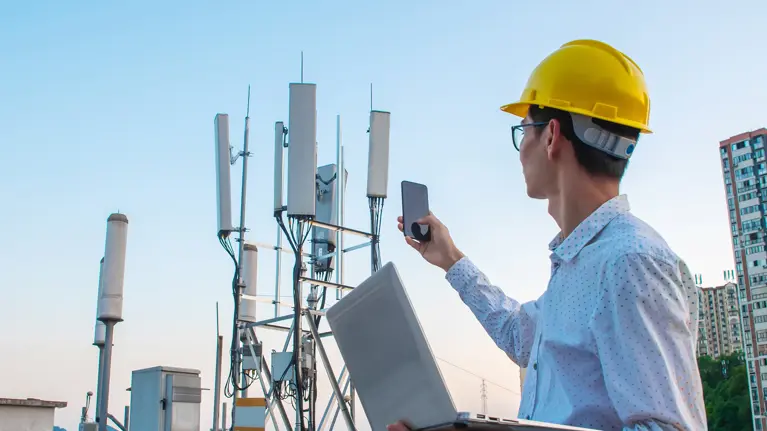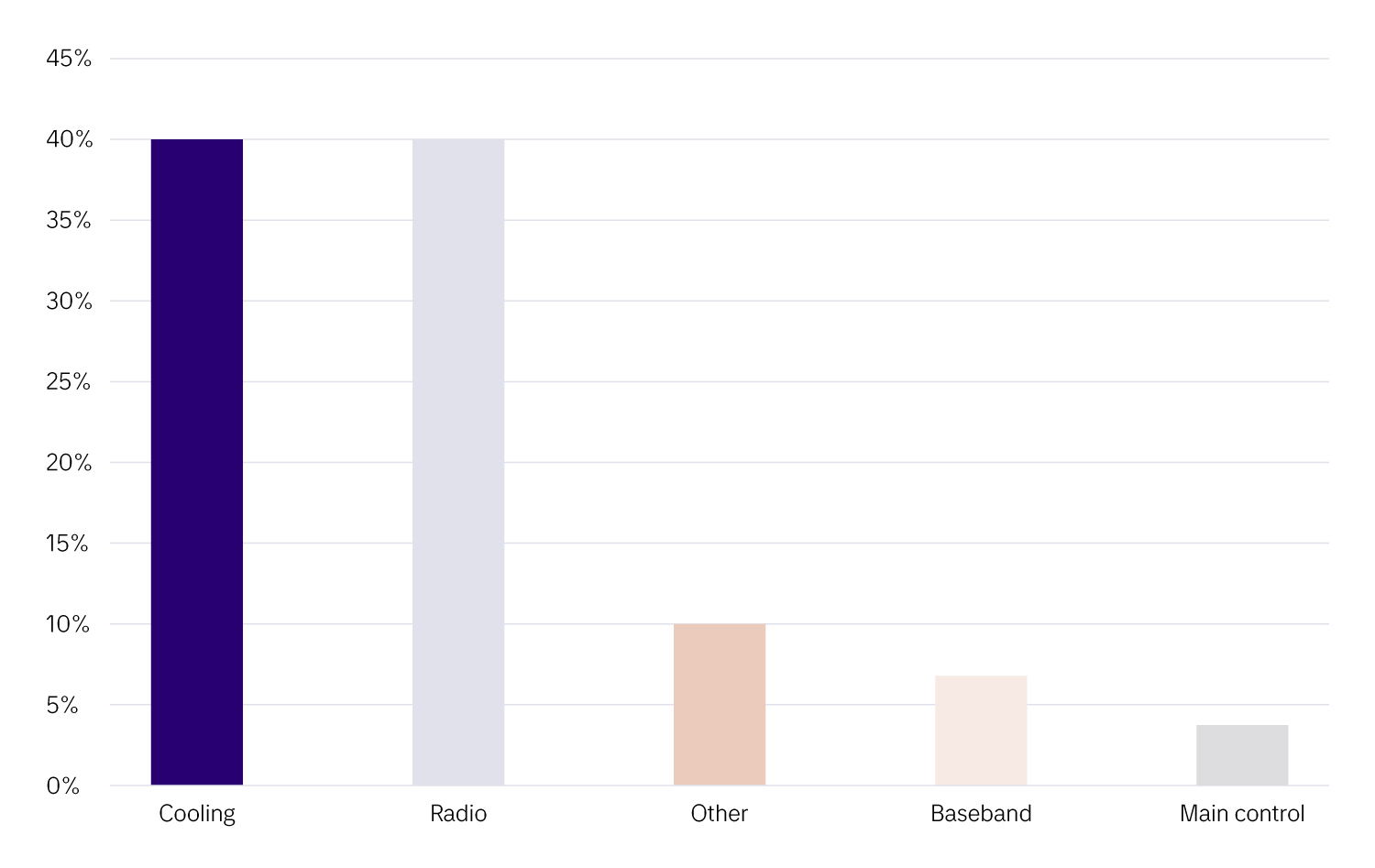
On energy use in RAN: why it didn’t explode as predicted and how to keep it down
Expert recommendations on sustainable telecom operations
Over the last decade, the explosion of internet use has raised concerns about how data centres and networks add to global electricity consumption. According to IEA, the number of internet user has grown two-fold since 2010, but the data volume expanded by 25 times.
Energy efficiency has been a growing concern over the last years. This assumed that electricity consumption grows with data volumes.
However, the latest figures show that the 1-1,5% of global electricity usage that is attributed to networks has remained flat despite a dramatic growth of data volumes. This increased efficiency is attributed to technological evolution, as well as to the specificity of, known as the energy proportionality – whether required power scales along with the computing load or transmitted data.
You can find more about why more data processing doesn’t by default translate into more energy consumed in our dedicated article: An Overview of Energy Consumption for Data Processing. There is also an article by Ericsson that outlines the proportionality topic further.
Energy efficiency is a complex and multifaceted concept. When talking about energy efficiency in our article, we refer to the total energy needed to transmit the data requested – energy per bit. As the energy consumed is not proportional to the bits transmitted that efficiency varies depending on the amount of data transmitted and other factors.
In a telecom perspective, energy consumption and energy efficiency of a single radio base station is a variable that is impacted by network planning and the size of the radio cell. Users at cell edge obviously require more energy for their transmission compared to users that are closer. The total energy consumed would therefore be highly impacted by network planning where additional radio base stations add idle energy consumption but may lead to smaller cells with less energy needed for transmission (and supporting a higher total data volume).
What drives energy consumption in RAN?
Many experts agree that out of a mobile network, the RAN contributes to the lion’s share of electricity consumed. The figures vary, depending on the source, but some reported.
So, what makes up those 70-80%? And how does it scale? According to an NGMN study, the consumed energy can be broken down into categories, where Cooling and Radio take the leading positions in consumption.
Energy consumption contribution for RAN

Let’s take a closer look at each category and what influences its energy efficiency.
The cooling aspect depends on several factors that affect its performance:
- heat generated inside the base station
- ambient temperature
- the chosen cooling technology and its efficiency.
For radio there is a higher level of proportionality since transmitting data inherently requires energy. So apart from the energy needed for transmitting data, some are also consumed by radios when idle. We should be aware of the efficiency of power amplifier that may be around 50% depending on various circumstances. This means that the power amplifier will consume twice as much energy as it emits.
An interesting point is the surprisingly low contribution from baseband - the part that together with the main control makes up the digital part of the base station. However, this number is expected to grow. With the continuous launch of new advanced signal processing features, such as MIMO, CoMP, etc., the portion attributed to baseband have increased substantially since the NGMN study and will continue to increase in the future.
These features implemented in baseband may also positively impact energy efficiency, as they may contribute to sending less data on the radio frequency interface, thus saving on the radio side (and remember the 50% efficiency). This reduction in radio-related energy consumption might be substantially bigger than the digital consumption caused by executing the algorithms, becoming a favorable trade-off.
When the digital part of energy consumption increases, the issue of energy proportionality becomes more prevalent. The digital aspect can become challenging for energy management and could lead to quite high idle energy consumption. We will elaborate on this in the coming sections.
Best practices for energy savings in network operations
Operating a mobile network is a complex task with so many ways to optimize the operations. In this section we cover some aspects to be considered by Mobile Network Operators to optimize the total network energy consumption.
Mobile networks come in generations (2G, 3G, etc.) as specified by 3GPP. This means that some energy efficiency properties are predefined by standards, like broadcast channel structures, modulation and so on. But energy efficiency is also a consequence of the design and technology used in a particular product, the frequency bands used, and the possible size of the cells.
This makes 5G a more efficient technology by default. However, specific products, for example MIMO, may have a high idle power consumption that influences energy efficiency when utilized with low data volumes. To account for all these details, we recommend the following.
Turn off older technologies
To begin with, older generations of RAN are less than newer in general. This means that if an MNO could replace 3G with 5G, they could save energy. Of course, every given case needs to be assessed separately, taking into account specific circumstances of frequency bands, their possible use for a newer generation, cell planning, etc. Such a sunset decision for 3G requires therefore careful consideration.
Upgrade your network with more modern equipment
Equipment that comes from vendor factories today is far more efficient than that produced 5 years ago. This means a return-on-investment and swap cycle that is often shorter than if such swap would be justified purely by CapEx.
Turn off unused resources
We know that base stations operate far from maximum capacity most of the time, due to data volumes fluctuating in time and geography. Therefore, MNO’s need to balance the installed capacity to sufficiently support network peak data volume time, for example at a summer day that requires extra cooling. As a result, most base stations are over-provisioned (radio, cooling, baseband) most of the time. MNO’s could therefore shut down cells or removing frequency bands dynamically – leading to substantial energy savings.
There is, however, a trade-off in this scenario. If the control loop cannot ramp it up quickly enough to meet a spike in demand, it can cause quality-of-experience issues. This challenge calls for accurate prediction algorithms that can foresee a demand within the time needed to react.
Shutting down unused resources depends on how the network was planned, such as cell overlaps. This is especially important for older RAN generations, since they are less efficient and consume more power even when idle.
Areas where Tietoevry Create can help
Tietoevry Create is engaged in network automation solutions that help MNO’s minimize unused resources. Based on emerging RAN Intelligent Controller platforms from Open RAN architectures, we help MNO’s and vendors to create AI-driven solutions energy saving and traffic steering. Powered by industry-specific algorithms, our AI solutions enable effective shutdown of under-utilized cells, help disable spectrum bands to save energy, and can move user traffic to other cells.
Our clients can save up to 30% with AI-powered solution, all depending on the preconditions.
Reach out and we will assist in solving your challenge by developing and deploying such solutions.

Mats Eriksson leads business development and sales in the telecom and radio access sector in Tietoevry Create. He has previously co-founded technology companies and held managerial positions in various companies. He has a background in academia where he was in charge of a research cooperation institute and founded an EU innovation initiative.



